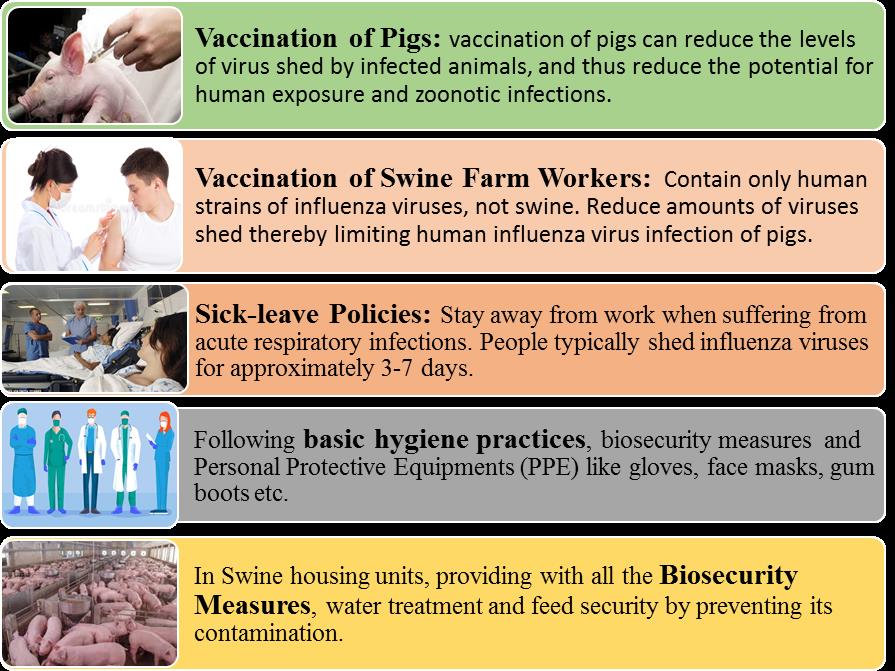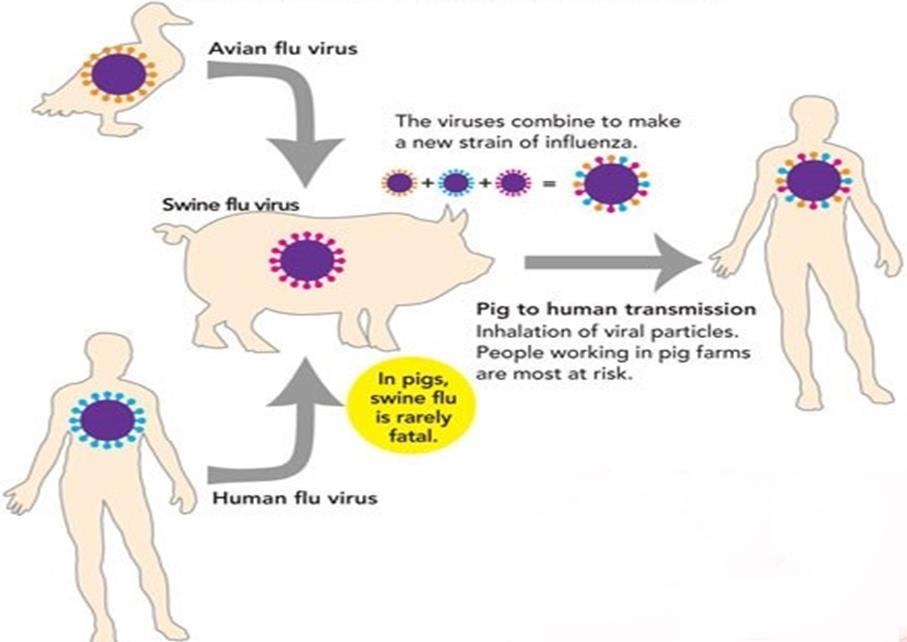FLICKERY SWINE FLU: UNUSUAL COCKTAIL OF SWINE, AVIAN AND HUMAN VIRUSES
Dr. Richa Tiwari1, Dr. Shalini Pandey2
1BVSc & AH, MVSc in Veterinary Public Health and Epidemiology, Guru Angad Dev Veterinary and Animal Sciences University, Ludhiana, Punjab, India.
2BVSc & AH, MVSc in Veterinary Microbiology, Guru Angad Dev Veterinary and Animal Sciences University, Ludhiana, Punjab, India.
E-mail id- richatiwarivet@gmail.com, Contact no.- 8872935989
INTRODUCTION
In many parts of the developing world, pigs under low-input systems roam freely to scavenge food and this allows poor farmers with an opportunity to initiate livestock rearing without large capital investments. Pigs are an important source of household income and food security in many rural based economies of developing countries. Food animal’s environment and systems are driven by unique ecological, social, and economic factors with intense interactions between animals, humans, and pathogens. The high-profile emergence of human diseases from animals, such as Nipah virus infection, SARS, and highly pathogenic avian influenza (HPAI), have accelerated public awareness of linkages between animal populations and human health.
It is estimated that three out of four emerging pathogens affecting humans over the past 10 years have originated from animals or animal products.
UNDERSTANDING SWINE FLU:
Swine flu is caused by a virus belonging to any strain of the influenza family of viruses that is endemic in pigs and common throughout pig populations worldwide. H1N1 swine flu leads to respiratory disease of pigs thereby having the potential to cause infections in humans if antigenic characteristics of the virus change through reassortment. In 1918, a deadly influenza pandemic caused by H1N1 influenza virus, also known as the Spanish flu, infected approximately 500 million people around the world and resulted in the deaths of 50 to 100 million people. The H1N1 swine flu descendants of the 1918 circulated in humans through the 20th century, leading to dispersion of a new strain of H1N1 around the world among humans, and thus World Health Organization (WHO) labelled it as pandemic. Over 10,000 reported cases and 774 deaths in India is caused by the same 2009 global pandemic mutant strain of H1N1, in the year 2015. Therefore this virus has attracted the most deserved attention from the scientific world considering its fastest exponentiation and infectious character in the history of mankind. Pig acts as reservoir for influenza viruses causing reinfection, once human immunity to these strains has waned. Outbreaks in swine are common, causing significant economic losses in industry.
CLASSIFICATION:
S.NO. Type of Influenza Virus Characteristics
- Influenza virus A
- Common in pigs.
Subtypes H1N1, H1N2, H3N1, H3N2, and H2N3 cause Swine Influenza.
Subtypes (H1N1, H3N2, and H1N2) are the most common strains worldwide. - Influenza virus C
- It is rare and lack genetic diversity.
Does not cause pandemics in humans.
Infect both humans and pigs, but do not infect birds.
Limited host range - Influenza virus B Not reported in pigs
Within influenza virus A and influenza virus C, the strains found in pigs and humans are largely distinct, although due to reassortment, there have been transfers of genes among strains crossing swine, avian, and human species boundaries.
The tracheal epithelium in pigs has receptors for both human and avian influenza viruses, and this makes them susceptible to both the viruses. Pigs can therefore function as intermediate hosts or “mixing vessels” in establishing new influenza virus lineages by supporting co-infection, replication, and re-assortment among human, avian and swine influenza viruses.
What is H3n2v?
H3N2v is a non-human influenza virus that normally circulates in pigs and that has infected humans. Viruses that normally circulate in pigs are “swine influenza viruses” and when these viruses infect humans, they are termed as “variant” viruses. In 2011, a specific H3N2 virus was detected with genes from avian, swine and human viruses and with H1N1 pandemic virus gene. The virus was circulating in pigs in 2010 and was first detected in people in 2011.
THE HOSTS AND TRANSMISSION:
Aquatic birds are natural reservoir of influenza A viruses, where viruses after achieving an optimal level of host adaptation occasionally transmit to other animals, including mammals and domestic poultry, causing transitory infections and outbreaks. Epidemics or epizootics in the new host is caused due to mutation or genetic re-assortment in some viruses by establishing species-specific permanent lineages. Swine influenza virus stays with pigs and transmission occurs via contact with respiratory secretions from infected pigs and fomites, air droplets, contaminated inanimate objects and people moving between infected and uninfected pigs. As the virus is enzootic in most densely swine populated regions, therefore it is impossible to prevent SIV infections by sanitary measures alone. Outbreaks of swine influenza are most commonly associated with the introduction of new animals into a herd. The incubation period is usually 1–3 days. Excretion of virus in pigs occurs within 24 hrs of infection, and shedding of virus may last up to 7-10 days. A carrier state can exist for up to 3 months.
HUMAN TRANSMISSION:
People who work with poultry and swine, are at increased risk of zoonotic infection and constitute a population of human hosts in which zoonosis and re-assortment can co‐occur. Other professions such as veterinarians and meat processing workers, are at higher risk
infection. Some evidence also suggest that it can spread through gastrointestinal means, such as saliva, vomit and faeces (stool). Patients with chronic lung diseases, cardiac disease and pregnant women are at higher risk of severe complications such as viral pneumonia, haemorrhagic bronchitis and possibly death. Industrial food animal workers act as a ‘‘bridge’’ for influenza A viruses between animal and human communities.

SIGN AND SYMPTOMS OF SWINE FLU:
According to Centres for Disease Control and Prevention (CDC), signs and symptoms in humans include fever and chills, cough, sore throat, congested eyes, myalgia, shortness of breath, weight loss, chills, sneezing, headache, rhinorrhoea, coughing, dizziness, abdominal pain, decreased appetite, and fatigue.
PANDEMIC FLU:
Pandemic flu occurs when a new influenza virus spreads quickly and kill a few million people globally. The most severe flu pandemic on record was the 1918 Spanish Flu. Researchers estimated, that it killed about 50 million people around the world.
IS IT SAFE TO EAT PORK AND PORK PRODUCTS?
Yes, there is no evidence that Swine flu transmits through eating processed pork and other pork products. However, it is essential to cook the meat properly at around 70oC or 160oF, as at this temperature viruses which potentially present in raw meat products readily gets inactivated and killed.
The following steps are potentially useful to reduce transmission of influenza viruses between pigs and people:
CONCLUSION:
The concern regarding H1N1 demonstrates the importance of comprehensive examination of biological, economic and social motivators with implications for both animal and human health. As food production becomes increasingly international, local public health risks become the global ones. Despite widespread influenza surveillance in humans, the lack of systematic swine surveillance leads to undetected persistence and evolution of this potentially pandemic strain for many years.
The emergence of a human influenza pandemic of animal origin, has led to the increased epidemiological and laboratory surveillance of interspecies transmission of influenza viruses especially in environments in which humans and swine are routinely exposed to each other. All this facilitate early identification and joint responses of public health and animal health agencies to cover potential outbreaks before widespread community transmission occurs. Interactions between food animals, pathogens, and humans must be viewed as part of a dynamic whole, thereby understanding the interface between them.


